 A ramble through the grounds of the USDA/TARS-
A ramble through the grounds of the USDA/TARS-
the Tropical Agriculture Research Station of Mayagüez.
This facility was on my original ‘hit list’.
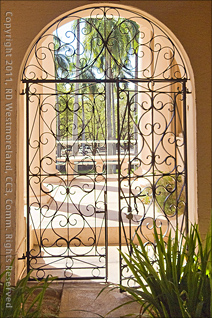 There are lots of references to it on the Net. Here’s a link to the TropAg Research Station. It is an extension of the University of Puerto Rico and the UPR Mayagüez campus is next door. In addition to several other sites in the US, the USDA/ARS also maintains a 120 acre research farm in Isabella.
There are lots of references to it on the Net. Here’s a link to the TropAg Research Station. It is an extension of the University of Puerto Rico and the UPR Mayagüez campus is next door. In addition to several other sites in the US, the USDA/ARS also maintains a 120 acre research farm in Isabella. 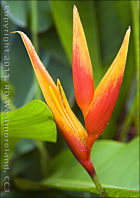 Unfortunately, it’s closed to the public. I tried to set-up a private tour of it, but was turned down because they use heavy equipment there. maybe some other time…
Unfortunately, it’s closed to the public. I tried to set-up a private tour of it, but was turned down because they use heavy equipment there. maybe some other time…
The TropAg Station of Mayagüez was built in 1909, but the program dates back to 1901. Only 3 years after the US took Puerto Rico from the Spanish. It’s been in full service ever since. A beautiful building done in a mission style from the period. Being 100 years old, it’s well maintained, including the surrounding grounds, with only minor exceptions. As always, parking was tight and there was hardly anyone visiting the day we were there.

In fact, we only ran into one other visitor the whole time we were there.
I spent 3 hours shooting though you could probably cover it all in about 1.5 to 2 hours. It is open from 7AM to 4PM during normal work days.
There are over 2,000 plant species on the property.
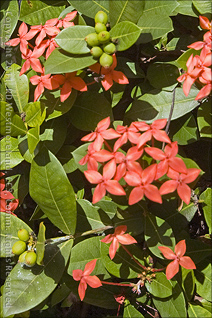 If you are a fine art or nature
If you are a fine art or nature
photographer or gardener,
this is a fantastic place!
Driving in from San Juan would take a good 2 hours no matter which route you take. It’s pretty much on the opposite side of the island from San Juan. 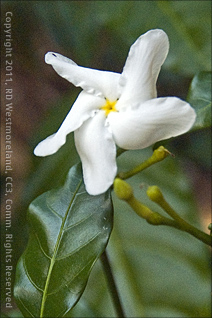 If you come in from Tollway 52 via Ponce it eventually becomes Hwy 2. After you pass through Ponce, the going is slower. Its in good shape, but you will get caught up in the local traffic.. with lots of stop lights. Or you could come from the Northside via Arecibo via Tollway 22 and Pr 2. This will take you through Aguadilla. Once you hit Mayagüez, you get off onto Pr 2r (North). Pr 2r takes you past the entrance of the University of PR on your left. Stay to the left and get onto Pr 65. The TropAg Station is on your immediate left. The sign is easy to miss like we did, so we had to backtrack after turning onto Pr 108. BTW: PR 108 takes you to the Mayagüez Zoo as covered in a previous story, also worth checking out as its the only Zoo on the island. If you are physically fit and bring water, you could probably do both in the same day.
If you come in from Tollway 52 via Ponce it eventually becomes Hwy 2. After you pass through Ponce, the going is slower. Its in good shape, but you will get caught up in the local traffic.. with lots of stop lights. Or you could come from the Northside via Arecibo via Tollway 22 and Pr 2. This will take you through Aguadilla. Once you hit Mayagüez, you get off onto Pr 2r (North). Pr 2r takes you past the entrance of the University of PR on your left. Stay to the left and get onto Pr 65. The TropAg Station is on your immediate left. The sign is easy to miss like we did, so we had to backtrack after turning onto Pr 108. BTW: PR 108 takes you to the Mayagüez Zoo as covered in a previous story, also worth checking out as its the only Zoo on the island. If you are physically fit and bring water, you could probably do both in the same day.
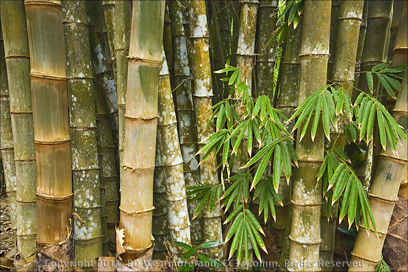 Its important to check in at the main building upon arrival so you can score the 2 color map of the grounds and sign the guest register. Straight up the steps to the office in the back, suite 204. The only public restrooms and drinking water are in the main building so plan accordingly. Once you take off, you are on your own to explore so the map is quite handy.
Its important to check in at the main building upon arrival so you can score the 2 color map of the grounds and sign the guest register. Straight up the steps to the office in the back, suite 204. The only public restrooms and drinking water are in the main building so plan accordingly. Once you take off, you are on your own to explore so the map is quite handy.
A very well done, hand drawn map.
I should also state that since this is January, most flowering plants were in stasis. I’m sure the grounds are covered in blooms in the Spring and Summer. Yep, PR has seasons. The winter months are very dry. Hence the dead grass everywhere. Some tropical plants thrive no matter what so there was still plenty to shoot.
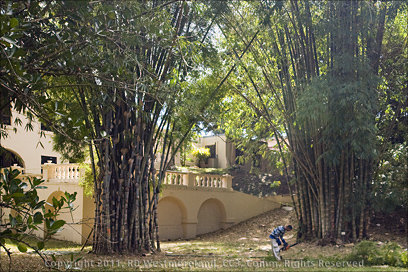 One of the things that most impressed me about the place was the size of plants, bamboo and trees growing here. Since this is an older facility, many of the trees were well over 60 feet tall. So much so, that it was hard to infer scale with my shots. There were several Palm trees that had trunks over 4 feet in diameter with canopies that spread over 40 feet.
One of the things that most impressed me about the place was the size of plants, bamboo and trees growing here. Since this is an older facility, many of the trees were well over 60 feet tall. So much so, that it was hard to infer scale with my shots. There were several Palm trees that had trunks over 4 feet in diameter with canopies that spread over 40 feet.
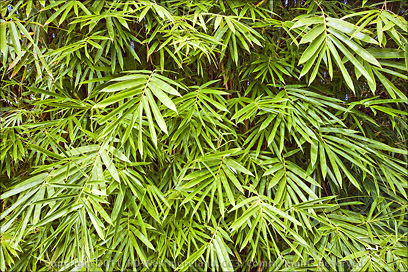 The lower garden off the parking lot had several interesting plants and trees.
The lower garden off the parking lot had several interesting plants and trees.
There were several examples of tropical hardwoods in this area. the Jungleflame Ixora hedges bounding both sides of the narrow cement walkway were overgrown with spider webs. I’m used to that out where we live so I grabbed a dead branch off the ground and knocked them back so I could get by. A minor inconvenience. There was a small stand of Freycinetia Multiflora.. of the Pandanaceae family from Papua, New Gunea. It resembled bamboo at a distance.. a hearty looking shrub.
My particular interest, Tropical Bamboo…
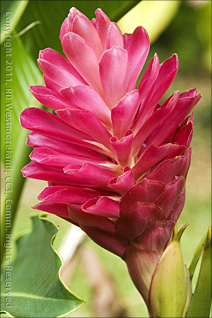 To the left and somewhat behind the main building are several stands of old growth tropical bamboo. The TropAg Station was originally dedicated to bamboo research and was instrumental in using bamboo as a way to reduce hillside erosion. So much so, that you can find Bambusa vulgaris all over the island.
To the left and somewhat behind the main building are several stands of old growth tropical bamboo. The TropAg Station was originally dedicated to bamboo research and was instrumental in using bamboo as a way to reduce hillside erosion. So much so, that you can find Bambusa vulgaris all over the island.
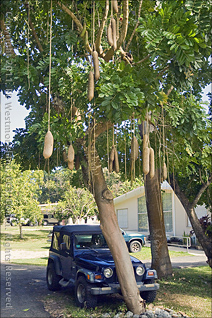 It is the single most prolific bamboo on the planet.
It is the single most prolific bamboo on the planet.
It gets a bad rap because it’s high in starch and as such, attracts beetles quite quickly (if not treated with Borax and Boric Acid after harvest). It will grow under adverse conditions so it’s very adaptable. It is what’s called a “Clumper” so it does not spread out as quickly as some types of bamboo. Mature bamboo culms (of the Bambusa vugaris variety) can be used for light to medium duty construction if treated. Many folks consider it a nuisance and I can see that, but there are other varieties suitable for construction and craft work. Something East Asia and Central America are developing into very profitable industries.
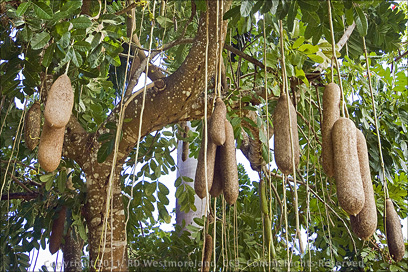 The mature bamboo stands were well over 40 feet tall.
The mature bamboo stands were well over 40 feet tall.
There was a guy there trimming some of it back.. he’s about 5’10” tall so you can get a sense of scale. The tallest ones were 5 to 7 inches in diameter at the base. I could carry on about the virtues of bamboo, but I’ll save that for another time.
On the hill up above the old bamboo stands were dedicated living quarters for staff. This area was off limits to the general public so we skirted around it for a few shots. 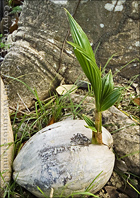 There was an example of a Sausage tree from Africa.. something I had not seen before.
There was an example of a Sausage tree from Africa.. something I had not seen before.  I picked up one of the dropped ‘sausages’ to examine it and broke it open. Lots of seeds surrounded by a very fibrous filler. A strange looking tree, for sure. Near it, was a coconut with a fresh sprout popping out. Similar to the ones I have started at home.
I picked up one of the dropped ‘sausages’ to examine it and broke it open. Lots of seeds surrounded by a very fibrous filler. A strange looking tree, for sure. Near it, was a coconut with a fresh sprout popping out. Similar to the ones I have started at home.
From there, we headed back down via the parking lot, past the front of the main building to the far right of the property. This path takes you around to the greenhouses at the back of the gardens. We saw an example of the Panama Canoe Tree.. also quite huge in it’s own right.
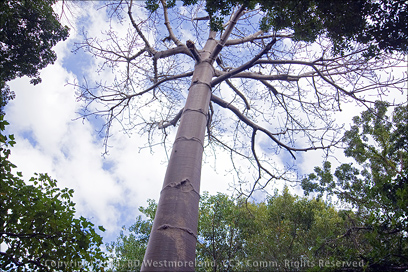 That was followed by examples of Miracle Fruit, a Soapberry Tree, another Sausage Tree,
That was followed by examples of Miracle Fruit, a Soapberry Tree, another Sausage Tree,
a Bulletwood Tree, a Camphor Tree and a Garcinia Tree
bearing fruit.
The most intriguing Garcinia is also known as the Monkey Fruit Tree. There were hundreds of dropped, rotting fruit on the ground with a few yellow fruit still hanging. They somewhat resembled a small peach both in size and texture of fruit, though I did not try to eat one. The pit looked more like an oversized kidney bean. Mangosteens also fall under this category.
Between the greenhouse area and the main building is a very large yard (for lack of a better description) with beds dedicated to specific kinds of temperate bamboo.  Without containment, some of these plants would spread underground via an aggressive root system. There were also several varieties of Plantains (bananas) situated near the greenhouses.
Without containment, some of these plants would spread underground via an aggressive root system. There were also several varieties of Plantains (bananas) situated near the greenhouses.  On the path back towards the main building was another huge stand of bamboo flanked by several varieties of Ginger and Carambola (Star Fruit) with ripe fruit hanging from it. Both grow almost wild here in PR.
On the path back towards the main building was another huge stand of bamboo flanked by several varieties of Ginger and Carambola (Star Fruit) with ripe fruit hanging from it. Both grow almost wild here in PR.
We had spent about 3 hours on our feet at this point so it was time to head back.
I had complained about theDry Forest of Guánica not having any places to sit down and take a break and neither does the TropAg Station. There are a couple of concrete benches out front, but they badly need to place a few benches on the backside of the gardens.. near the greenhouses maybe. 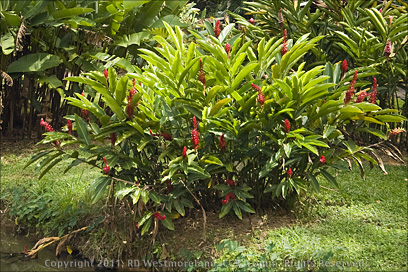 Something cheap and simple.
Something cheap and simple.
The park is free, but it would not be inappropriate to solicit donations with a ‘blind box’ at the table where visitors sign the guest book. Its a very common practice. I would have tossed a few dollars their way. Something like that could help defray costs.
The map lists 96 specific types of plants, bamboo and trees of which we might have identified 25 to 30. It would probably take all day to check out all 96!
All my quibbles are minor… Its well worth the trip and I have no problem giving it 5 Skulls. ARRG! I will come back here during the Spring or Summer to shoot again.
A wonderful, low pressure experience.
After signing out, we head back to the parking lot and then back home.


John Loessner says
This is a must see place in Puerto Rico.
Patria says
Great entry, Roberto! I have been lavishing my Orchids with much needed tender loving care; transplanting and separating some of them, feeding others… and I second what Lou said!
michael says
I searched for bamboo culms and I found your blog. I really like it. Keep going – well done!
Lou Quave says
I would like to thank you for the time you took writing this post. You’re an inspiration for me. I’ve forwarded this to one of my friends.